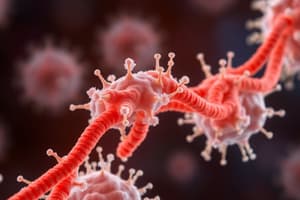Podcast
Questions and Answers
What role does the Gal4 protein play in the activation of eukaryotic genes?
What role does the Gal4 protein play in the activation of eukaryotic genes?
- It serves as a transcription activator by recruiting the Pol II complex to regulatory sites. (correct)
- It functions as a coactivator by interacting directly with RNA Polymerase.
- It represses transcription by blocking access to the promoter.
- It binds directly to the promoter region and initiates transcription.
Which type of proteins are required at every Pol II promoter in eukaryotic gene transcription?
Which type of proteins are required at every Pol II promoter in eukaryotic gene transcription?
- Repressors
- Activators
- General transcription factors (correct)
- HMG proteins
HMG proteins play a critical role in eukaryotic gene expression by:
HMG proteins play a critical role in eukaryotic gene expression by:
- Inhibiting the function of coactivators.
- Bringing distant DNA regulatory elements near the promoter. (correct)
- Encoding the components of the RNA Polymerase II complex.
- Binding directly to the promoter region to enhance transcription.
Which of the following statements correctly describes a function of coactivators in eukaryotic transcription?
Which of the following statements correctly describes a function of coactivators in eukaryotic transcription?
In the context of gene repression mechanisms in eukaryotes, which of the following roles do repressors typically perform?
In the context of gene repression mechanisms in eukaryotes, which of the following roles do repressors typically perform?
What is the role of GAL80 protein in the regulation of GAL gene expression without galactose?
What is the role of GAL80 protein in the regulation of GAL gene expression without galactose?
During the presence of galactose, what is the function of Gal3p in the regulation of GAL genes?
During the presence of galactose, what is the function of Gal3p in the regulation of GAL genes?
Which of the following accurately describes the DNA-binding domain of HMG proteins?
Which of the following accurately describes the DNA-binding domain of HMG proteins?
What is the primary role of transcription repressors in eukaryotic gene regulation?
What is the primary role of transcription repressors in eukaryotic gene regulation?
Which of the following structural GAL genes are responsible for the metabolism of galactose in yeast?
Which of the following structural GAL genes are responsible for the metabolism of galactose in yeast?
What is the significance of the TATA box in the promoters of GAL genes?
What is the significance of the TATA box in the promoters of GAL genes?
What happens to Gal4p when Gal80p is inactivated by Gal3p upon galactose presence?
What happens to Gal4p when Gal80p is inactivated by Gal3p upon galactose presence?
What is the key feature of the Mobility Shift Assay when assessing the binding of TF-x to the promoter region of Gene-Y?
What is the key feature of the Mobility Shift Assay when assessing the binding of TF-x to the promoter region of Gene-Y?
What is the underlying mechanism that allows genetic imprinting to affect gene expression?
What is the underlying mechanism that allows genetic imprinting to affect gene expression?
Which mechanism describes the inactivation of one X chromosome in female mammals?
Which mechanism describes the inactivation of one X chromosome in female mammals?
How does traditional Mendelian inheritance differ from genetic imprinting?
How does traditional Mendelian inheritance differ from genetic imprinting?
What is the role of CTCF in the regulation of the IGF2 gene?
What is the role of CTCF in the regulation of the IGF2 gene?
What occurs in the yeast two-hybrid assay?
What occurs in the yeast two-hybrid assay?
What is a common outcome of dosage compensation in organisms with sex chromosomes?
What is a common outcome of dosage compensation in organisms with sex chromosomes?
Which statement accurately reflects the concept of dosage compensation?
Which statement accurately reflects the concept of dosage compensation?
What is the significance of the Yeast GAL Expression System in gene regulation?
What is the significance of the Yeast GAL Expression System in gene regulation?
Which regulatory mechanism is characterized as being epigenetic in nature?
Which regulatory mechanism is characterized as being epigenetic in nature?
Flashcards
HMG proteins
HMG proteins
Proteins that bend DNA to form loops between enhancer and promoter regions.
Transcription factors
Transcription factors
Proteins that regulate gene expression by binding specific DNA sequences
Repressors (Eukaryotic)
Repressors (Eukaryotic)
Proteins that bind to specific DNA sequences and prevent transcription.
GAL4 protein
GAL4 protein
Signup and view all the flashcards
GAL80 protein
GAL80 protein
Signup and view all the flashcards
GAL3 protein
GAL3 protein
Signup and view all the flashcards
UASGAL
UASGAL
Signup and view all the flashcards
TATA Binding Protein (TBP)
TATA Binding Protein (TBP)
Signup and view all the flashcards
Enhancer
Enhancer
Signup and view all the flashcards
Upstream Activating Sequence (UAS)
Upstream Activating Sequence (UAS)
Signup and view all the flashcards
Coactivator
Coactivator
Signup and view all the flashcards
Heterodimer
Heterodimer
Signup and view all the flashcards
Fos and Jun
Fos and Jun
Signup and view all the flashcards
Mobility Shift Assay
Mobility Shift Assay
Signup and view all the flashcards
Genetic Imprinting
Genetic Imprinting
Signup and view all the flashcards
Epigenetic Mechanism
Epigenetic Mechanism
Signup and view all the flashcards
IGF2 Gene Imprinting
IGF2 Gene Imprinting
Signup and view all the flashcards
Dosage Compensation
Dosage Compensation
Signup and view all the flashcards
Barr Body
Barr Body
Signup and view all the flashcards
Insulator
Insulator
Signup and view all the flashcards
Methylation
Methylation
Signup and view all the flashcards
Study Notes
BIOL 366 Lecture 15: Gene Expression in Eukaryotes I
- Lecture covers the yeast Gal operon and its applications, plus regulatory mechanisms unique to eukaryotes.
- Text section is 21.1.1–21.3.
- Slides will be updated before the Tuesday lecture.
Announcements
- Exam III is on November 22nd, with a review/questions on November 20th.
- Exam is cumulative, covering lectures 1–15.
- Exam format is like midterm II, including multiple-choice and written questions.
- Exam is 60 minutes long, similar to midterm II.
- Review will be next Tuesday.
- Two to three more assignments will be given on remaining lectures.
- Final exam is cumulative, with 50% of the final grade based on material after Exam II and 50% before Exam II, weighting each lecture equally.
Eukaryotic Promoters
- Eukaryotic promoters vary in complexity.
- More complex organisms have more complex promoters and control elements.
- Changes in gene expression occur during development, intercellular communication, and interaction with the environment.
- Mammalian gene promoters range from -50 to -10 kilobases (-kbp) to +10 to +50 kbp.
- Yeast gene promoters range from -250 to +1.
Eukaryotic RNA Polymerases
- All three eukaryotic RNA polymerases have little to no affinity for their promoters.
- They almost always require activator and coactivator proteins.
Regulatory Proteins
- General transcription factors are always required.
- DNA-binding transcription activators (transactivators) are important.
- DNA-binding transcription coactivators also play a role.
- Repressors are used in some cases.
- TFIID is a crucial general transcription factor.
Activation of Eukaryotic Genes
- General (basal) transcription factors are proteins required for every Pol II promoter.
- They bind the promoter region near the gene.
- Example: TATA binding Protein (TBP).
- Upstream Activating Sequences (UAS) are regulatory sites in yeast.
- Activators bind distant regulatory sites (enhancers in higher eukaryotes), recruiting Pol II complex to the promoter.
- Example: Gal4 in yeast.
- Coactivators function as bridges between activators and RNA Pol II.
- They do not directly interact with DNA.
- Example: Mediator and TFIID.
- High-Mobility Group (HMG) proteins bend DNA, leading to looping between enhancers and promoters, their binding is non-specific.
Repression of Eukaryotic Genes
- Repressors bind specific DNA sequences and inhibit transcription.
- They may disrupt contacts between Pol II and activators or coactivators.
Yeast GAL Expression System
- GAL genes allow yeast to take in and metabolize galactose.
- There are four structural Gal genes (GAL1, GAL10, GAL2, and GAL7) located in different genome loci, controlled by the same regulatory proteins.
- There are three regulatory genes:
- GAL4: DNA-binding transcription activator (transactivator)
- GAL80: Repressor
- GAL3: Ligand (galactose) sensor
- GAL gene promoters consist of a TATA box and one or more upstream activator sequences (UASGAL).
- UASGAL site is recognized by the Gal4 protein, a DNA-binding transactivator.
Roles of Gal3p, Gal4p, and Gal80p
- Gal4p binds UASGAL; Gal80p prevents Gal4p's activation of Pol II in the absence of galactose.
- Gal3p, activated by galactose, binds Gal80p, changing its conformation, and inactivating it.
- This releases Gal4p, allowing it to bind Pol II, activating transcription.
Yeast Two-hybrid Assay
- A method to detect protein-protein interactions using Gal4 protein and yeast GAL genes.
- A reporter gene is placed under GAL promoter control.
- DNA-binding domain of Gal4 is fused to protein X; RNA polymerase-activating domain fused to protein Y.
- If proteins X and Y interact, DNA-binding and activation domains of Gal4 come together, activating the GAL promoter.
Other Transcription Factors
- Some transcription factors (TFs) form functional heterodimers.
- Most eukaryotic TFs bind DNA as homodimers.
- However, structurally related eukaryotic transcription factors can form heterodimers.
- Hypothetical family of four different but related proteins could form up to 10 different dimeric species.
- Each dimeric species may have unique activity.
- Example: mammalian AP-1 TFs (e.g., Fos, Jun) control cell proliferation and differentiation.
- AP-1 family members have basic leucine zipper types for protein dimerization and DNA binding.
Mobility Shift Assay
- Used to determine if a transcription factor (TF-x) binds to a promoter region of a gene (gene-Y).
- Purified TF-x is mixed with labeled genomic DNA fragment from gene-Y, run on a polyacrylamide gel, and visualized.
- Changes in DNA mobility indicate TF-x binding.
Two Regulatory Mechanisms Unique to Eukaryotes
- Genetic Imprinting: Some eukaryotes turn expression of specific alleles from one parent on and off. It is an epigenetic process based on methylation of cytosine residues and is independent from Mendelian inheritance.
- Dosage Compensation: Maintaining equal gene expression levels between sexes with different sized chromosomes (XX females and XY males). Three mechanisms exist that deal with this regulation.
Studying That Suits You
Use AI to generate personalized quizzes and flashcards to suit your learning preferences.





